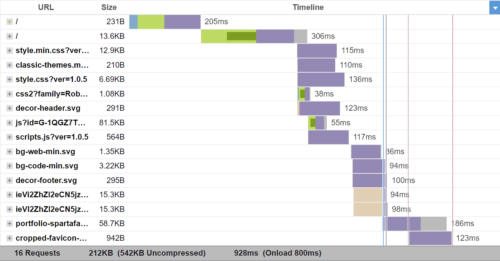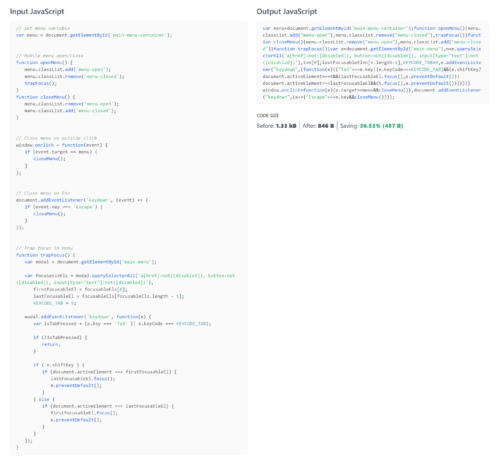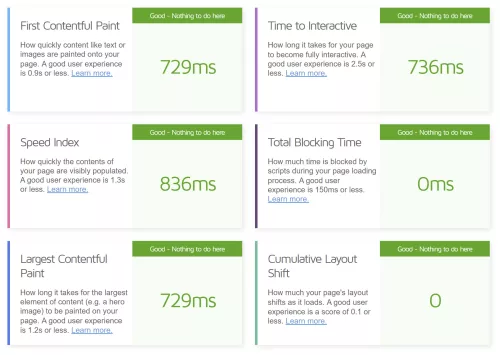
On the fast-paced web, where first impressions are crucial and attention spans are short, ensuring your website is in peak shape is essential. Just as individuals strive to shed excess weight and improve their overall well-being, web designers and developers must embark on a journey to optimize their websites for speed and efficiency. In this “Weight Loss Guide” for the web, we’ll explore the parallels between website optimization and human weight loss, shedding those unnecessary “pounds” from your website to achieve a leaner, faster, and more user-friendly online presence.
Similar to an athlete striving to be in peak condition, optimizing your website begins with recognizing the importance of speed and efficiency. A sluggish website can be just as detrimental as carrying excess weight, leading to frustrated visitors, higher bounce rates, and diminished search engine rankings. By prioritizing website performance, you can create an exceptional user experience that captivates and retains your audience.
So, let’s lace up our virtual sneakers, tighten our digital belts, and get ready to embark on this transformative journey. Prepare to witness the powerful impact of website optimization as we uncover the secrets to a healthier, faster, and more efficient online presence. Are you ready to shed those website pounds? Let’s begin.
Understanding Website Performance
Understanding the importance of website performance is paramount. Just as excess weight can hinder physical performance and overall well-being, the weight of a website—referring to its file sizes, code complexity, and overall efficiency—can significantly impact its performance. In this section, we’ll delve into the crucial connection between website speed, user experience, and search engine optimization (SEO), highlighting the need to shed those unnecessary “pounds” from your website.
- The Impact of Website Speed on User Experience:
In today’s fast-paced digital landscape, users have little patience for slow-loading websites. Research shows that visitors expect websites to load within a few seconds, and even a slight delay can lead to frustration and abandonment. Just as shedding weight can improve physical agility, a faster website enhances user experience by delivering content swiftly and seamlessly, ensuring visitors can effortlessly navigate through your site. - The Benefits of a Lightweight Website:
Similar to the way excess weight affects an individual’s mobility and overall health, a heavy website can hinder performance user engagement. Website weight refers to factors such as large file sizes, unnecessary code, and inefficient resource handling. These factors contribute to slower load times, increased bandwidth consumption, and higher server demands. By shedding website weight, you can enhance performance, reduce load times, and improve overall efficiency. - The Relationship Between Website Speed and SEO:
Search engines, like users, prioritize fast-loading websites. In fact, website speed is a significant ranking factor in search engine algorithms. A slow website may experience lower search engine rankings, resulting in reduced visibility and organic traffic. By optimizing your website for speed and efficiency, you not only provide a better user experience but also increase your chances of ranking higher in search engine results pages (SERPs).
Optimizing your website’s performance contributes to an exceptional user experience, improved search engine visibility, and increased engagement. Hopefully, you now have a greater appreciation for website optimization, and recognize the necessity of shedding those excess “pounds” from your website.
In the next sections, we’ll dive deeper into specific techniques and strategies for shedding website weight and achieving optimal performance. Get ready to uncover the secrets of efficient coding, streamlined file sizes, and powerful optimization tools. Let’s trim the excess and make your website a lean, mean, high-performing machine.
Minimizing File Sizes
When it comes to optimizing website performance, reducing file sizes plays a vital role in achieving faster load times and improved user experience. Just as individuals strive to shed pounds through diet and exercise, minimizing the size of your website files is crucial for achieving a lean and efficient online presence. In this section, we’ll explore the importance of file size reduction and delve into effective techniques for compressing HTML, CSS, and JavaScript files, as well as provide tips for code minification and removing unnecessary elements.
- Importance of File Size Reduction:
Similar to how excess weight burdens physical performance, large file sizes are detrimental to website performance. Hefty HTML, CSS, and JavaScript files take longer to download, increasing load times and potentially frustrating users. By minimizing file sizes, you can significantly reduce the time it takes for your website to load, resulting in faster page rendering and improved overall performance. - Techniques for Compressing HTML, CSS, and JavaScript Files:
There are various techniques and tools available for compressing HTML, CSS, and JavaScript files, effectively reducing their size without compromising functionality. One common method is minification, which involves removing unnecessary spaces, line breaks, and comments from the code, resulting in a more compact file. Additionally, you can use compression algorithms, such as Gzip, to further reduce file sizes by compressing them before sending them to the user’s browser. - Tips for Code Minification and Removing Unnecessary Elements:
Code minification goes beyond compressing files. It involves optimizing the code structure by removing redundant or unused elements, such as unused CSS styles, unused JavaScript functions, or redundant HTML tags. By eliminating unnecessary code, you can significantly reduce file sizes and improve website performance. Additionally, consider removing any unused or unnecessary images, fonts, or media files that contribute to the overall weight of your website.
Implementing these techniques and applying code minification practices can effectively reduce the file sizes of your HTML, CSS, and JavaScript files, promoting faster load times and a more streamlined user experience. Remember, just as shedding excess weight leads to improved physical performance, minimizing file sizes paves the way for a faster, more efficient website.
Image Optimization
Minimizing image file size is a crucial aspect of website dieting. Images often constitute a significant portion of a website’s file size, making them a prime target for optimization. In this section, we’ll explore the significance of image optimization in improving website speed and delve into the world of image compression techniques and formats. We’ll also discuss best practices for resizing, compressing, and selecting the appropriate image format.
- Significance of Image Optimization:
Images play a vital role in enhancing the visual appeal of a website, but they can also contribute to slower load times if not properly optimized. Large image files can significantly increase the page weight, leading to longer download times and a slower user experience. By optimizing images, you can strike a balance between visual quality and file size, resulting in faster load times and improved website performance. - Image Compression Techniques and Formats:
Finding the right balance of image quality and file size is the key to image optimization. There are two primary types of image compression: lossless and lossy. Lossless compression retains all image data while reducing file size, making it ideal for graphics and illustrations. Lossy compression, on the other hand, selectively discards image data to achieve greater file size reduction, making it suitable for photographs and images with subtle details. Carefully consider the various image formats, such as JPEG, PNG, and WebP, as they each offer different compression capabilities and are suited for specific types of images. - Best Practices for Resizing, Compressing, and Choosing Image Formats:
To optimize images effectively, it’s crucial to follow best practices. Start by resizing images to the appropriate dimensions needed for your website. Avoid using large images and scaling them down, as this can result in unnecessary file bloat. Next, compress the images using appropriate compression techniques and tools. Experiment with different compression settings to find the optimal balance between file size and visual quality. Lastly, choose the right image format based on the content and purpose of the image. JPEG is commonly used for photographs, PNG for graphics and images with transparency, and WebP for modern browsers that support it. Even better yet, SVG format enables you to use vector graphics for crisp edges and super small file size.
By implementing these image optimization practices, you can significantly reduce the file sizes of your images while maintaining visual quality. Remember, just as shedding excess weight improves physical performance, optimizing images contributes to a faster, more efficient website.
Caching and Content Delivery Networks (CDNs)
Just as maintaining a healthy metabolism aids in maintaining weight loss, leveraging caching and CDNs can further boost your website’s speed and performance. In this section, we’ll explore the power of caching and CDNs in optimizing content delivery, resulting in faster load times and improved user experiences.
Browser caching allows web browsers to store static resources of a website, such as images, CSS files, and JavaScript files, locally on a user’s device. By caching these resources, subsequent visits to the website can be quicker since the browser doesn’t need to download them again. Caching reduces the number of HTTP requests and minimizes the time required to fetch resources, resulting in improved load times and overall website performance.
Content Delivery Networks are globally distributed networks of servers that store cached copies of your website’s static content in multiple locations. When a user requests your website, the CDN serves the content from the server closest to the user, reducing the distance and network latency. CDNs not only improve load times for users located far from your server but also help handle traffic spikes and distribute bandwidth more efficiently.
Tips for Implementing Caching and Utilizing CDNs Effectively:
- Set proper cache headers: Ensure that your web server is configured to send appropriate cache headers, such as Cache-Control and Expires, to instruct browsers on how long to cache resources. Use versioning or cache-busting techniques to ensure updated resources are fetched when necessary.
- Utilize CDNs: Consider using a reputable CDN provider to distribute your website’s static content globally. Research and compare different CDN options based on performance, coverage, and pricing to find the most suitable solution for your needs.
- Implement dynamic caching: If your website has dynamic content that can be cached, implement server-side caching mechanisms to reduce the load on your web server and improve response times. CMS platforms like WordPress have plugins available to set this up.
- Regularly monitor and update caching settings: Periodically review and adjust caching settings to accommodate changes in your website’s content and resources. Update cache expiration times when necessary to ensure users receive the latest versions of your content.
Lazy Loading and Deferred Loading
Sometimes being a little lazy can be a good thing, especially when it comes to website performance optimization. In this section, we’ll delve into the benefits of lazy loading and deferred loading techniques, and how they can significantly improve your website’s speed and efficiency.
Benefits of Lazy Loading and Deferred Loading:
- Faster Initial Page Load: Lazy loading and deferred loading techniques allow you to load only the essential content when a user first visits your website, reducing the initial page load time.
- Improved User Experience: By loading content progressively as users scroll or interact with your website, you can provide a smooth and uninterrupted browsing experience, avoiding long loading times and reducing the risk of visitors bouncing away.
- Bandwidth Optimization: Lazy loading helps conserve bandwidth by loading images and other resources only when they are needed, particularly useful for websites with extensive media content.
- Reduced Server Load: With lazy loading implemented, your server is given fewer simultaneous requests, reducing the strain on your web hosting infrastructure during peak traffic periods.
How These Techniques Improve Website Performance:
- Lazy Loading: Lazy loading is a technique that defers the loading of non-critical resources, such as images, videos, or ads, until they are about to come into the user’s viewport. This approach significantly speeds up the initial page load time by only loading the visible content first, while the rest loads as the user scrolls down the page.
- Deferred Loading: Deferred loading involves delaying the loading of certain scripts or assets that are not necessary for the initial rendering of the page. By deferring the loading of these resources until after the critical content has been loaded, you ensure that your website’s core functionality is not affected.
Implementing Lazy Loading Images, Scripts, and Other Assets:
- Lazy Loading Images: Use JavaScript libraries or built-in HTML attributes like
loading="lazy"to instruct images to lazy load. This allows images below the fold to load only when they are close to becoming visible to the user. - Lazy Loading Scripts: Employ asynchronous loading techniques for non-critical scripts, allowing the browser to continue rendering the page without waiting for the scripts to fully load.
- Deferred Loading of Non-Critical Resources: Identify resources that can be loaded after the initial page load, such as social media widgets, external scripts, or third-party integrations. Load them dynamically once the primary content has been rendered.
Remember to test and optimize the lazy loading and deferred loading implementations to ensure they work seamlessly across different browsers and devices. Monitoring your website’s performance and making necessary adjustments will help you strike the right balance between load time and content delivery.
Optimizing Third-Party Scripts and Plugins
While third-party scripts and plugins can enhance the functionality and features of your website, they can also introduce potential bottlenecks and negatively impact performance. In this section, we’ll discuss the importance of evaluating and optimizing third-party scripts and plugins to ensure they don’t hinder your website’s speed and efficiency.
Evaluating and Optimizing Third-Party Scripts and Plugins:
- Performance Impact: Third-party scripts and plugins can increase the overall load time of your website, as they often require additional HTTP requests, DNS lookups, and can be resource-intensive.
- Dependency Risks: Relying heavily on third-party resources makes your website susceptible to performance issues, downtime, or compatibility conflicts.
- User Experience: Slow-loading or malfunctioning third-party components can lead to a poor user experience, frustrating visitors and potentially driving them away.
Reducing Dependencies and Minimizing the Impact of External Resources:
- Evaluate the Necessity: Assess how critical each third-party script or plugin is for your website. Remove or replace those that aren’t essential to your website’s core functionality.
- Minify and Concatenate: Minify and concatenate multiple scripts and stylesheets to reduce the number of requests and file sizes. This helps optimize the delivery of third-party resources.
- Load Asynchronously: Load third-party scripts asynchronously to prevent them from blocking the rendering of your web page. This ensures that the critical content loads first and improves the perceived performance.
- Prioritize Critical Resources: Identify critical third-party scripts or plugins required for the initial page rendering and load them first. Load non-essential components later or on-demand as needed.
- Monitor Performance: Regularly monitor the performance impact of third-party resources using web performance tools. Identify and address any bottlenecks or issues that may arise.
Remember to keep an eye on updates or alternatives for third-party scripts and plugins. Periodically reassess their performance and consider replacing outdated or poorly performing ones with more efficient options.
Performance Testing and Monitoring
To ensure your website is running at its optimal speed and efficiency, it’s crucial to regularly perform performance testing and monitoring. This section introduces you to valuable tools and techniques that help measure website speed, identify bottlenecks, and make improvements.
Tools for Performance Testing and Monitoring:

- Google PageSpeed Insights: A popular tool that analyzes your website’s performance, providing insights and suggestions for improvement.
- GTmetrix: This tool offers detailed performance reports, including page load times, waterfall charts, and recommendations for optimization.
- WebPageTest: An advanced testing tool that allows you to simulate real-world browsing scenarios and offers in-depth performance analysis.
- Pingdom: Provides performance monitoring, uptime monitoring, and alerts to help you track and improve your website’s speed.
- Lighthouse: Built into the Google Chrome browser, Lighthouse audits your website’s performance, accessibility, SEO, and more.
Tips for Measuring Website Speed and Identifying Bottlenecks:
- Conduct Regular Speed Tests: Perform periodic speed tests using various tools to gain insight into your website’s performance.
- Analyze Waterfall Charts: Examine waterfall charts provided by performance testing tools to identify resource-heavy elements and potential bottlenecks.
- Focus on Key Metrics: Pay attention to metrics like time to first byte (TTFB), first contentful paint (FCP), and largest contentful paint (LCP) to gauge your website’s speed.
- Use Browser Developer Tools: Leverage the developer tools built into browsers to analyze network requests, inspect DOM elements, and monitor performance metrics.
- Monitor Server Response Time: Keep an eye on your server response time and ensure it’s optimized for quick and efficient handling of requests.
Start Shedding the Kilobytes
In this website weight loss guide, we have explored the importance of optimizing web design for speed and efficiency. Just as shedding excess weight can transform your health and well-being, optimizing your website’s performance can have a significant impact on user experience, SEO rankings, and overall success.
Now, armed with these powerful techniques, it’s time to take action. Implementing these optimizations will help you create a website that loads swiftly, engages visitors, and drives conversions. Remember, a faster website not only enhances user experience but also improves search engine rankings, leading to increased visibility and traffic.
So, go forth and optimize! Your users will thank you, search engines will reward you, and your online presence will shine brighter than ever before. Here’s to a fast, efficient, and successful website!


